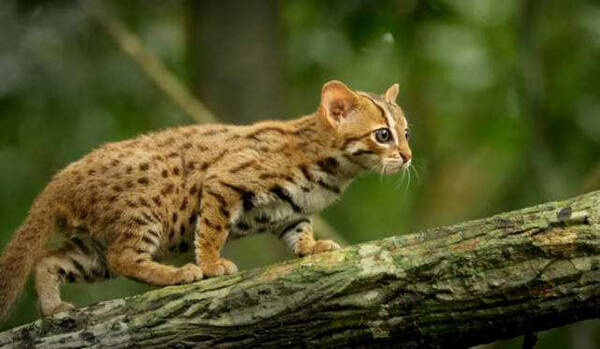Prionailurus rubiginosus
IUCN
LCBasic Information
Scientific classification
- name:Prionailurus rubiginosus
- Scientific Name:Prionailurus rubiginosus,Rusty-spotted Cat,Rusty Cat
- Outline:Carnivora
- Family:Schizopoda Felinae Ocelot
Vital signs
- length:35-48cm
- Weight:800-1600g
- lifetime:About 16 years
Feature
It is one of the smallest species in the cat family.
Distribution and Habitat
Distributed in India (Andhra Pradesh, Gujarat, Jammu and Kashmir, Karnataka, Kerala, Madhya Pradesh, Maharashtra, Orissa, Rajasthan, Tamil Nadu, Uttaranchal, Uttar Pradesh), Nepal, Sri Lanka.
The rusty-spotted cat lives in the southern part of the Indian peninsula and Sri Lanka. In India, the rusty-spotted cat is mainly found in moist deciduous forests, drier scrubland and open grasslands, and is occasionally found in Gir Forest National Park in northern India. The rusty-spotted cat in Sri Lanka mainly lives in alpine forests at an altitude of about 2,100 meters, and is relatively rare in the arid areas north of the island. This difference may be due to the fact that the leopard cat occupies the rainforests of India, but does not live in Sri Lanka.
Appearance
The rusty-spotted cat is one of the smallest species in the cat family, with a head and body length of 35-48 cm, a tail length of 15-29 cm, and a weight of 0.8-1.6 kg. It is only half the size of an ordinary domestic cat. The rusty-spotted cat has a small head, small and round ears, a pair of bright big eyes, and a circle of white eyeliner around the eyes. The ears are relatively small. There are two dark stripes on the cheeks, and four black stripes extending from the eyes, from the ears to the shoulders. The body is slender, the limbs are short, and the pads are black. The tail is about half the length of the body and there are no obvious stripes. The fur color is mainly red, with several reddish-brown stripes or spots painted vertically on the body, and there are also several horizontal stripes on the outside of the limbs and chest. Their chin, the inside of the limbs, and the chest and abdomen are all white. There is a faint dark ring mark on the tail.
The fur color of the subsp
Details
Rusty-spotted cat (scientific name: Prionailurus rubiginosus), also known as Rusty-spotted Cat, or simply Rusty-spotted cat, is a very small wild cat with two subspecies.

Rusty-spotted cats are small, agile, and active. They are nocturnal animals. They mostly sleep in their dens during the day and come out at night. They live semi-arboreal and are good climbers. They can easily hunt in trees. They mainly catch birds and small rodent mammals, but they also catch reptiles, lizards, insects, and frogs to supplement their nutrition. In addition, they will attack human poultry whenever possible.
In India, rusty-spotted cats breed in the spring, with a gestation period of about 67 days and one to three cubs born each time. The little ones only develop the same markings as their parents when they grow up. In captivity, rusty-spotted cats can live for about 16 years. The breeding season is from January to March, the gestation period is 10 weeks, and kittens are generally born around April. Kittens have thicker fur than adult cats.
Deforestation and habitat loss are the main threats to the survival of the rusty-spotted cat. Although the rusty-spotted cat is sometimes hunted by locals for food, the main threat to the survival of the rusty-spotted cat is still the loss of habitat. Since 2000, people in southern India have also found traces of them in abandoned houses in human settlements, and in Sri Lanka, people have also seen rusty-spotted cats in tea gardens, indicating that they have a certain ability to adapt to environmental changes. Both India and Sri Lanka have enacted laws to protect rusty-spotted cats.
Listed in the 2021 Red List of Endangered Species of the World Conservation Union (IUCN) - Near Threatened (NT).
The Indian subspecies is listed in the CITES Appendix I of the Washington Convention.
The Sri Lankan subspecies is listed in the CITES Appendix II of the Washington Convention.
Protect wild animals and stop eating game.
Maintaining ecological balance is everyone's responsibility!








